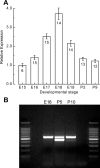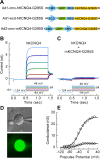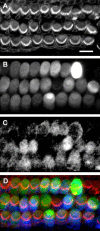Dominant-negative inhibition of M-like potassium conductances in hair cells of the mouse inner ear
- PMID: 17699675
- PMCID: PMC2647843
- DOI: 10.1523/JNEUROSCI.2085-07.2007
Dominant-negative inhibition of M-like potassium conductances in hair cells of the mouse inner ear
Abstract
Sensory hair cells of the inner ear express multiple physiologically defined conductances, including mechanotransduction, Ca(2+), Na(+), and several distinct K(+) conductances, all of which are critical for normal hearing and balance function. Yet, the molecular underpinnings and their specific contributions to sensory signaling in the inner ear remain obscure. We sought to identify hair-cell conductances mediated by KCNQ4, which, when mutated, causes the dominant progressive hearing loss DFNA2. We used the dominant-negative pore mutation G285S and packaged the coding sequence of KCNQ4 into adenoviral vectors. We transfected auditory and vestibular hair cells of organotypic cultures generated from the postnatal mouse inner ear. Cochlear outer hair cells and vestibular type I cells that expressed the transfection marker, green fluorescent protein, and the dominant-negative KCNQ4 construct lacked the M-like conductances that typify nontransfected control hair cells. As such, we conclude that the M-like conductances in mouse auditory and vestibular hair cells can include KCNQ4 subunits and may also include KCNQ4 coassembly partners. To examine the function of M-like conductances in hair cells, we recorded from cells transfected with mutant KCNQ4 and injected transduction current waveforms in current-clamp mode. Because the M-like conductances were active at rest, they contributed to the very low potassium-selective input resistance, which in turn hyperpolarized the resting potential and significantly attenuated the amplitude of the receptor potential. Modulation of M-like conductances may allow hair cells the ability to control the amplitude of their response to sensory stimuli.
Figures









Similar articles
-
The function and molecular identity of inward rectifier channels in vestibular hair cells of the mouse inner ear.J Neurophysiol. 2012 Jul;108(1):175-86. doi: 10.1152/jn.00098.2012. Epub 2012 Apr 11. J Neurophysiol. 2012. PMID: 22496522 Free PMC article.
-
Mice with altered KCNQ4 K+ channels implicate sensory outer hair cells in human progressive deafness.EMBO J. 2006 Feb 8;25(3):642-52. doi: 10.1038/sj.emboj.7600951. Epub 2006 Jan 26. EMBO J. 2006. PMID: 16437162 Free PMC article.
-
Differential expression of KCNQ4 in inner hair cells and sensory neurons is the basis of progressive high-frequency hearing loss.J Neurosci. 2005 Oct 5;25(40):9285-93. doi: 10.1523/JNEUROSCI.2110-05.2005. J Neurosci. 2005. PMID: 16207888 Free PMC article.
-
Channeling your inner ear potassium: K(+) channels in vestibular hair cells.Hear Res. 2016 Aug;338:40-51. doi: 10.1016/j.heares.2016.01.015. Epub 2016 Feb 4. Hear Res. 2016. PMID: 26836968 Review.
-
KCNQ4 mutations associated with nonsyndromic progressive sensorineural hearing loss.Curr Opin Otolaryngol Head Neck Surg. 2008 Oct;16(5):441-4. doi: 10.1097/MOO.0b013e32830f4aa3. Curr Opin Otolaryngol Head Neck Surg. 2008. PMID: 18797286 Free PMC article. Review.
Cited by
-
Cellular and molecular mechanisms of autosomal dominant form of progressive hearing loss, DFNA2.J Biol Chem. 2011 Jan 14;286(2):1517-27. doi: 10.1074/jbc.M110.179010. Epub 2010 Oct 21. J Biol Chem. 2011. PMID: 20966080 Free PMC article.
-
A potassium channel agonist protects hearing function and promotes outer hair cell survival in a mouse model for age-related hearing loss.Cell Death Dis. 2022 Jul 11;13(7):595. doi: 10.1038/s41419-022-04915-5. Cell Death Dis. 2022. PMID: 35817766 Free PMC article.
-
Extracellular chloride regulation of Kv2.1, contributor to the major outward Kv current in mammalian outer hair cells.Am J Physiol Cell Physiol. 2012 Jan 1;302(1):C296-306. doi: 10.1152/ajpcell.00177.2011. Epub 2011 Sep 21. Am J Physiol Cell Physiol. 2012. PMID: 21940671 Free PMC article.
-
Effect of M-current modulation on mammalian vestibular responses to transient head motion.J Neurophysiol. 2017 Dec 1;118(6):2991-3006. doi: 10.1152/jn.00384.2017. Epub 2017 Aug 30. J Neurophysiol. 2017. PMID: 28855291 Free PMC article.
-
Genetic Polymorphisms Associated with Hearing Threshold Shift in Subjects during First Encounter with Occupational Impulse Noise.PLoS One. 2015 Jun 29;10(6):e0130827. doi: 10.1371/journal.pone.0130827. eCollection 2015. PLoS One. 2015. PMID: 26121033 Free PMC article.
References
-
- Beisel KW, Nelson NC, Delimont DC, Fritzsch B. Longitudinal gradients of KCNQ4 expression in spiral ganglion and cochlear hair cells correlate with progressive hearing loss in DFNA2. Brain Res Mol Brain Res. 2000;82:137–149. - PubMed
-
- Brown DA, Adams PR. Muscarinic suppression of a novel voltage-sensitive K+ current in a vertebrate neurone. Nature. 1980;283:673–676. - PubMed
-
- Chambard JM, Ashmore JF. Regulation of the voltage-gated potassium channel KCNQ4 in the auditory pathway. Pflugers Arch. 2005;450:34–44. - PubMed
Publication types
MeSH terms
Substances
Grants and funding
LinkOut - more resources
Full Text Sources
Molecular Biology Databases
Research Materials
Miscellaneous
